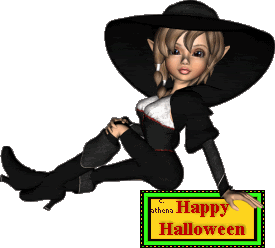
History of Halloween
Behind the name... Halloween or the Hallow E'en as they call it in Ireland , means All Hallows Eve, or the night before the 'All Hallows', also called 'All Hallowmas', or 'All Saints', or 'All Souls' Day, observed on November 1.
In old English the word 'Hallow' meant 'sanctify'.
Roman Catholics, Episcopalians and Lutherians used to observe All Hallows Day to honor all Saints in heaven, known or unknown.
They used to consider it with all solemnity as one of the most significant observances of the Church year.
And Catholics, all and sundry, was obliged to attend Mass. The Romans observed the holiday of Feralia, intended to give rest and peace to the departed.
Participants made sacrifices in honor of the dead, offered up prayers for them, and made oblations to them.
The festival was celebrated on February 21, the end of the Roman year.
In the 7th century, Pope Boniface IV introduced All Saints' Day to replace the pagan festival of the dead. It was observed on May 13. Later, Gregory III changed the date to November 1.
The Greek Orthodox Church observes it on the first Sunday after Pentecost.
Despite this connection with the Roman Church, the American version of Halloween Day celebration owes its origin to the ancient (pre-Christian) Druidic fire festival called "Samhain", celebrated by the Celts in Scotland, Wales and Ireland.
Samhain is pronounced "sow-in", with "sow" rhyming with cow.
In Ireland the festival was known as Samhein, or La Samon, the Feast of the Sun.
In Scotland, the celebration was known as Hallowe'en.
In Welsh it's Nos Galen-gaeof (that is, the Night of the Winter Calends.
According to the Irish English dictionary published by the Irish Texts Society: "Samhain, All Hallowtide, the feast of the dead in Pagan and Christian times, signalizing the close of harvest and the initiation of the winter season, lasting till May, during which troops (esp. the Fiann) were quartered.
Faeries were imagined as particularly active at this season.
From it the half year is reckoned also called Feile Moingfinne (Snow Goddess).
(1) The Scottish Gaelis Dictionary defines it as "Hallowtide. The Feast of All Soula. Sam + Fuin = end of summer."
(2) Contrary to the information published by many organizations, there is no archaeological or literary evidence to indicate that Samhain was a deity.
The Celtic Gods of the dead were Gwynn ap Nudd for the British, and Arawn for the Welsh.
The Irish did not have a "lord of death" as such. Thus most of the customs connected with the Day are remnants of the ancient religious beliefs and rituals, first of the Druids and then transcended amongst the Roman Christians who conquered them.
In old English the word 'Hallow' meant 'sanctify'.
Roman Catholics, Episcopalians and Lutherians used to observe All Hallows Day to honor all Saints in heaven, known or unknown.
They used to consider it with all solemnity as one of the most significant observances of the Church year.
And Catholics, all and sundry, was obliged to attend Mass. The Romans observed the holiday of Feralia, intended to give rest and peace to the departed.
Participants made sacrifices in honor of the dead, offered up prayers for them, and made oblations to them.
The festival was celebrated on February 21, the end of the Roman year.
In the 7th century, Pope Boniface IV introduced All Saints' Day to replace the pagan festival of the dead. It was observed on May 13. Later, Gregory III changed the date to November 1.
The Greek Orthodox Church observes it on the first Sunday after Pentecost.
Despite this connection with the Roman Church, the American version of Halloween Day celebration owes its origin to the ancient (pre-Christian) Druidic fire festival called "Samhain", celebrated by the Celts in Scotland, Wales and Ireland.
Samhain is pronounced "sow-in", with "sow" rhyming with cow.
In Ireland the festival was known as Samhein, or La Samon, the Feast of the Sun.
In Scotland, the celebration was known as Hallowe'en.
In Welsh it's Nos Galen-gaeof (that is, the Night of the Winter Calends.
According to the Irish English dictionary published by the Irish Texts Society: "Samhain, All Hallowtide, the feast of the dead in Pagan and Christian times, signalizing the close of harvest and the initiation of the winter season, lasting till May, during which troops (esp. the Fiann) were quartered.
Faeries were imagined as particularly active at this season.
From it the half year is reckoned also called Feile Moingfinne (Snow Goddess).
(1) The Scottish Gaelis Dictionary defines it as "Hallowtide. The Feast of All Soula. Sam + Fuin = end of summer."
(2) Contrary to the information published by many organizations, there is no archaeological or literary evidence to indicate that Samhain was a deity.
The Celtic Gods of the dead were Gwynn ap Nudd for the British, and Arawn for the Welsh.
The Irish did not have a "lord of death" as such. Thus most of the customs connected with the Day are remnants of the ancient religious beliefs and rituals, first of the Druids and then transcended amongst the Roman Christians who conquered them.



No comments:
Post a Comment
Thank you for your visit!